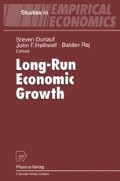Abstract
This paper develops a method to analyze large cross-sections with non-trivial time dimension. The method (i) identifies the number of common shocks in a factor analytic model; (ii) estimates the unobserved common dynamic component; (iii) shows how to test for fundamentalness of the common shocks; (iv) quantifies positive and negative comovements at each frequency. We illustrate how the proposed techniques can be used for analyzing features of the business cycle and economic growth.
Access this chapter
Tax calculation will be finalised at checkout
Purchases are for personal use only
Preview
Unable to display preview. Download preview PDF.
References
Brillinger DR (1981) Time series data analysis and theory. Holt, Rinehart and Winston Inc
Forni M, Lippi M (1995) Aggregation and the micro foundations of macroeconomics. Oxford, Oxford University Press, forthcoming
Forni M, Reichlin L (1995) Let’s get real: A dynamic factor analytic approach to disaggregated business cycle. CEPR working paper 1244
Geweke J (1982) Measurements of linear dependence and feedback between multiple time series. Journal of the American Statistical Association 77: 304–13
Geweke J, Singleton KJ (1981) Maximum likelihood confirmatory factor analysis of economic time series. International Economic Review 22 /1: 37–54
Granger CWJ (1987) Implication of aggregation with common factors. Econometric Theory 3: 208–22
Lippi M, Reichlin L (1993) The dynamic effects of aggregate demand and supply disturbances: Comment. American Economic Review
Quah D, Sargent TJ (1994) A dynamic index model for large cross sections. In: Stock J, Watson M (eds) Business cycles, indicators and forecasting. NBER and University Press of Chicago
Rozanov Y (1967) Stationary random processes. San Francisco, Holden Day
Sargent TJ, Sims CA (1977) Business cycle modelling without pretending to have too much a priori economic theory. In: Sims CA (ed) New methods in business research. Minneapolis, Federal Reserve Bank of Minneapolis
Author information
Authors and Affiliations
Editor information
Editors and Affiliations
Rights and permissions
Copyright information
© 1996 Physica-Verlag Heidelberg
About this paper
Cite this paper
Forni, M., Reichlin, L. (1996). Dynamic Common Factors in Large Cross-Sections. In: Durlauf, S., Helliwell, J.F., Raj, B. (eds) Long-Run Economic Growth. Studies in Empirical Economics. Physica-Verlag HD. https://doi.org/10.1007/978-3-642-61211-4_3
Download citation
DOI: https://doi.org/10.1007/978-3-642-61211-4_3
Publisher Name: Physica-Verlag HD
Print ISBN: 978-3-642-64747-5
Online ISBN: 978-3-642-61211-4
eBook Packages: Springer Book Archive

